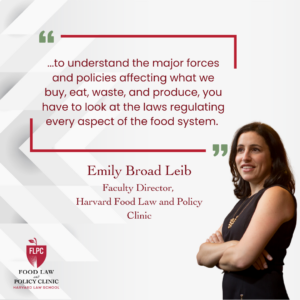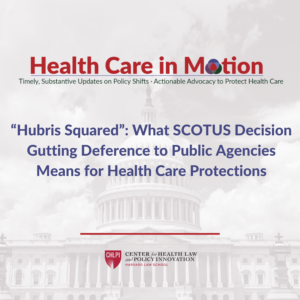This article was originally written by Erin O’Donnell and published in the September-October 2020 Edition of the Harvard Magazine.
In the United States, “The primary way we define ‘food safety’ is, ‘If I eat this product today, will I be in the hospital in 24 to 72 hours?’” says clinical professor of law Emily Broad Leib. “But this doesn’t account for other ways that the food system produces health risks for members of the public,” including the lifelong risks of, say, developing type 2 diabetes after consuming sugary foods for decades, or the environmental effects of industrial farming, such as fertilizer runoff in waterways, which creates oxygen-free dead zones inhospitable to aquatic life. The single-minded emphasis on microbes like salmonella and E. coli, Broad Leib asserts, “means we’re under-regulating a bunch of other risks that have bigger health impacts.”
As director of Harvard Law School’s Food Law and Policy Clinic, she engages law students in projects that investigate how U.S. law intersects with the broader food system, “from the first seed going into the ground, to someone’s plate or perhaps to a trashcan.” Her purview encompasses environmental impacts, worker safety, and even immigration as factors in food production.
This holistic, systems approach is a relatively new way to consider food law; when Broad Leib first made the case to law-school colleagues about her work, many misunderstood, thinking she was narrowly focused on foodborne illness or the work of the Food and Drug Administration (FDA). But Broad Leib says that in reality, a food-systems approach is “breathtakingly broad” in its scope. She sees this as a necessity. “This is the way we have to look at these issues,” she says, “or we’re going to continue to make really short-sighted, less equitable, less utilitarian policies.”
For that reason, Broad Leib considers issues such as conditions for workers at fruit and vegetable farms and meatpacking plants, which became COVID-19 hotspots during the spring and summer months. “We underpay and undervalue workers in the food system, and then they often become sick themselves,” she says. When workers lack job security and paid sick leave, many continue to work while sick, infecting fellow workers and potentially jeopardizing supply chains.
Nutrition is another often overlooked factor in food safety. In a paper published in California Law Review, she and coauthor Margot J. Pollans of Pace University note that in 2016, heart disease caused more than 635,000 deaths in the United States, or 200 times more than foodborne illness did. Heart disease is also responsible for an estimated $200 billion in medical costs, and $130.5 billion in lost productivity. Yet of the FDA’s 2016 budget for regulating the food supply, which came to nearly $1 billion, 98 percent was spent on traditional food-safety measures and just 2 percent on nutrition, a critical tool in addressing heart disease. “This is human nature,” Broad Leib says. “We overemphasize risks such as E. coli outbreaks that we read about in the news, and we undervalue these more pedestrian risks such as heart disease that accrue over time.”
Being clear-eyed about such health risks is important in identifying food-system priorities—and the COVID-19 era, she says, offers an ideal time for Congress, regulatory agencies, and others to reimagine the food system. Shoppers have new awareness of these issues, after seeing empty store shelves, headlines about sick workers, and news footage of farmers throwing away fresh potatoes and milk produced for hotels and cruise ships shut down during the pandemic. The food system is currently so specialized and efficient, Broad Leib asserts, that it cannot pivot when circumstances change. Eggs, for example, are often packaged in liquid form for use in industrial kitchens. But if those liquid eggs suddenly aren’t needed, they can’t be rerouted and sold in grocery stores—a frustrating scenario when data suggest that the number of “food insecure” people, those who lack sufficient affordable, nutritious food, has risen to unprecedented levels since the pandemic began.
A tangle of bureaucracy further complicates food-safety efforts in the United States. Fifteen different federal agencies—including the FDA, EPA, USDA, OSHA, and the Department of Commerce—have some role in the food supply, Broad Leib says: each with a narrow view of food safety, and little knowledge of how their individual missions might interact. She has proposed a reorganization to establish a new unified food-system agency better equipped to address interrelated food-system issues.
She also recommends gathering representatives of these federal agencies, plus consumers and other stakeholders, to establish priorities for the U.S. food system and address its interrelated impacts on safety, health, and the environment. In 2017, Broad Leib and colleagues from Vermont Law School developed a “Blueprint for a National Food Strategy,” outlining the process for creating such a strategy that drew on the food policies in place in six other countries and interviews with leaders in the U.S. food system. Canadian officials have already used that document as a blueprint, allocating “millions of dollars in funding to areas of the food system” where they identified “gaps and weaknesses,” she reports. Part of this effort included support for small, local food producers, and operational changes to reduce food waste at retail stores and within the federal government.
As lawmakers consider pandemic stimulus programs, Broad Leib and law students in the clinic have written to Congress and are drawing up briefs, articles, and blogs related to the food system. “My hope is that we can use the energy of the moment. Many groups are working on this,” she points out, but everyone can play a role by “putting the pressure on food businesses and policymakers, so we can find long-term solutions.”


Health Law & Policy, Commentary
Braidwood Management v. Becerra: Updated FAQs for Health Advocates and Providers
July 22, 2024